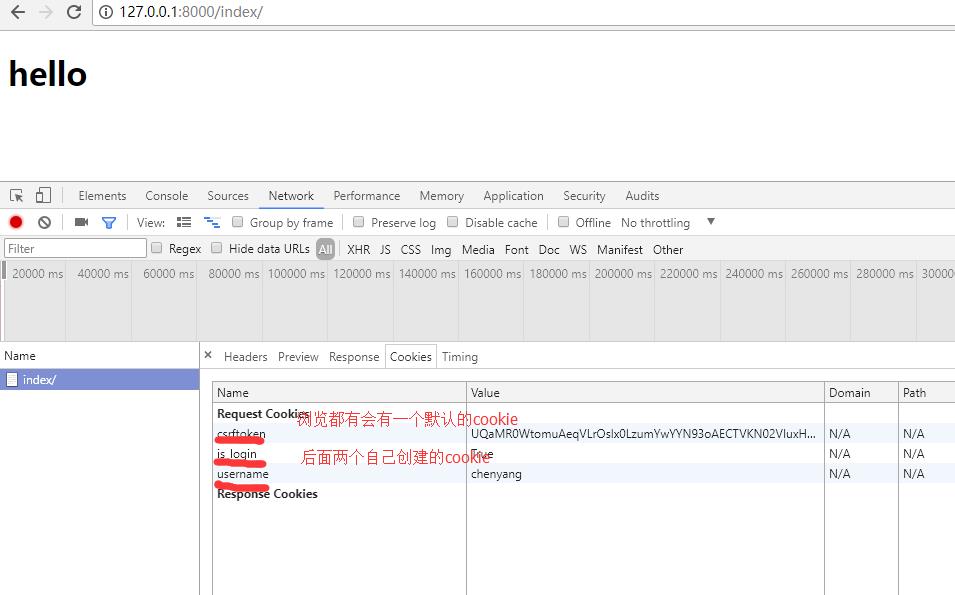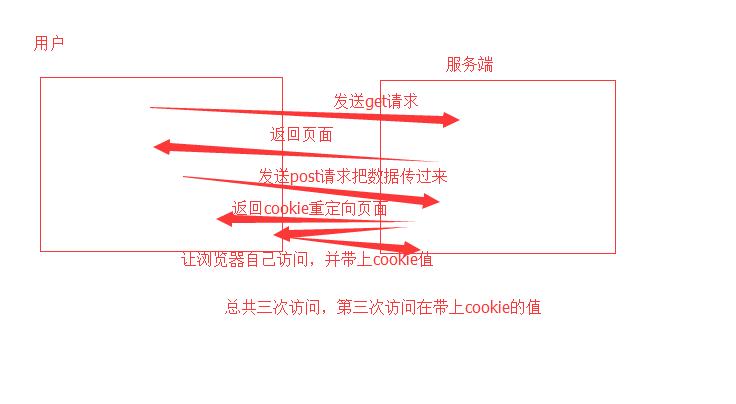django--认证系统
Posted 一只丶顽皮猫
tags:
篇首语:本文由小常识网(cha138.com)小编为大家整理,主要介绍了django--认证系统相关的知识,希望对你有一定的参考价值。
COOKIE 与 SESSION
概念
cookie不属于http协议范围,由于http协议无法保持状态,但实际情况,我们却又需要“保持状态”,因此cookie就是在这样一个场景下诞生。
cookie的工作原理是:由服务器产生内容,浏览器收到请求后保存在本地;当浏览器再次访问时,浏览器会自动带上cookie,这样服务器就能通过cookie的内容来判断这个是“谁”了。
cookie虽然在一定程度上解决了“保持状态”的需求,但是由于cookie本身最大支持4096字节,以及cookie本身保存在客户端,可能被拦截或窃取,因此就需要有一种新的东西,它能支持更多的字节,并且他保存在服务器,有较高的安全性。这就是session。
问题来了,基于http协议的无状态特征,服务器根本就不知道访问者是“谁”。那么上述的cookie就起到桥接的作用。
我们可以给每个客户端的cookie分配一个唯一的id,这样用户在访问时,通过cookie,服务器就知道来的人是“谁”。然后我们再根据不同的cookie的id,在服务器上保存一段时间的私密资料,如“账号密码”等等。
总结而言:cookie弥补了http无状态的不足,让服务器知道来的人是“谁”;但是cookie以文本的形式保存在本地,自身安全性较差;所以我们就通过cookie识别不同的用户,对应的在session里保存私密的信息以及超过4096字节的文本。
另外,上述所说的cookie和session其实是共通性的东西,不限于语言和框架
登陆应用
在验证了用户名和密码的正确性后跳转到后台的页面。但是测试后也发现,如果绕过登陆页面。直接输入后台的url地址也可以直接访问的。这个显然是不合理的。其实我们缺失的就是cookie和session配合的验证。有了这个验证过程,我们就可以实现和其他网站一样必须登录才能进入后台页面了。
先说一下这种认证的机制。每当我们使用一款浏览器访问一个登陆页面的时候,一旦我们通过了认证。服务器端就会发送一组随机唯一的字符串(假设是123abc)到浏览器端,这个被存储在浏览端的东西就叫cookie。而服务器端也会自己存储一下用户当前的状态,比如login=true,username=hahaha之类的用户信息。但是这种存储是以字典形式存储的,字典的唯一key就是刚才发给用户的唯一的cookie值。那么如果在服务器端查看session信息的话,理论上就会看到如下样子的字典
{\'123abc\':{\'login\':true,\'username:hahaha\'}}
因为每个cookie都是唯一的,所以我们在电脑上换个浏览器再登陆同一个网站也需要再次验证。那么为什么说我们只是理论上看到这样子的字典呢?因为处于安全性的考虑,其实对于上面那个大字典不光key值123abc是被加密的,value值{\'login\':true,\'username:hahaha\'}在服务器端也是一样被加密的。所以我们服务器上就算打开session信息看到的也是类似与以下样子的东西
{\'123abc\':dasdasdasd1231231da1231231}
Django中cookie的使用
1、获取Cookie
request.COOKIES[\'key\']
request.get_signed_cookie(key, default=RAISE_ERROR, salt=\'\', max_age=None)
#参数:
default: 默认值
salt: 加密盐
max_age: 后台控制过期时间xxxxxxxxxxrequest.COOKIES[\'key\']request.get_signed_cookie(key, default=RAISE_ERROR, salt=\'\', max_age=None) #参数: default: 默认值 salt: 加密盐 max_age: 后台控制过期时间2、设置Cookie
obj = redirect("/index/")
obj.set_cookie("is_login",True,20) #设置cookie的值,True,20代表这个cookie的过期时间
obj.set_cookie("username",username)xxxxxxxxxx obj = redirect("/index/") obj.set_cookie("is_login",True,20) #设置cookie的值,True,20代表这个cookie的过期时间 obj.set_cookie("username",username)3、cookie的参数
\'\'\'
def set_cookie(self, key, 键
value=\'\', 值
max_age=None, 超长时间
expires=None, 超长时间
path=\'/\', Cookie生效的路径,
浏览器只会把cookie回传给带有该路径的页面,这样可以避免将
cookie传给站点中的其他的应用。
/ 表示根路径,特殊的:根路径的cookie可以被任何url的页面访问
domain=None, Cookie生效的域名
你可用这个参数来构造一个跨站cookie。
如, domain=".example.com"
所构造的cookie对下面这些站点都是可读的:
www.example.com 、 www2.example.com
和an.other.sub.domain.example.com 。
如果该参数设置为 None ,cookie只能由设置它的站点读取。
secure=False, 如果设置为 True ,浏览器将通过HTTPS来回传cookie。
httponly=False 只能http协议传输,无法被javascript获取
(不是绝对,底层抓包可以获取到也可以被覆盖)
): pass
\'\'\'xxxxxxxxxx\'\'\'def set_cookie(self, key, 键 value=\'\', 值 max_age=None, 超长时间 expires=None, 超长时间 path=\'/\', Cookie生效的路径, 浏览器只会把cookie回传给带有该路径的页面,这样可以避免将 cookie传给站点中的其他的应用。 / 表示根路径,特殊的:根路径的cookie可以被任何url的页面访问 domain=None, Cookie生效的域名 你可用这个参数来构造一个跨站cookie。 如, domain=".example.com" 所构造的cookie对下面这些站点都是可读的: www.example.com 、 www2.example.com 和an.other.sub.domain.example.com 。 如果该参数设置为 None ,cookie只能由设置它的站点读取。 secure=False, 如果设置为 True ,浏览器将通过HTTPS来回传cookie。 httponly=False 只能http协议传输,无法被JavaScript获取 (不是绝对,底层抓包可以获取到也可以被覆盖) ): pass\'\'\'from django.shortcuts import render,HttpResponse,redirect
from app01 import models
# Create your views here.
from django.db.models import F,Q
def login(request):
if request.method=="POST":
username=request.POST.get("user")
password=request.POST.get("pwd")
print(type(password),username,password)
ret=models.Admin.objects.filter(name=username,password=password)
print(ret)
if ret:
obj = redirect("/index/")
obj.set_cookie("is_login",True,10) #设置cookie的值,True,20代表这个cookie的过期时间
obj.set_cookie("username",username) #可以发送多个值 set_的意思是发送一个集合
return obj
else:
return redirect(request,"/login")
return render(request,"login.html")
def index(request):
is_login=request.COOKIES.get(\'is_login\') #当验证成功后重定向到index页面中,通过COOKIES取到自己定义的cookie值,
if is_login: #然后进行判断有cookie的话为True
username=request.COOKIES.get(\'username\')
# if is_login:
# name=request.
return render(request,"index.html",locals())
else:
return redirect("/login/")x
from django.shortcuts import render,HttpResponse,redirectfrom app01 import models# Create your views here.from django.db.models import F,Qdef login(request): if request.method=="POST": username=request.POST.get("user") password=request.POST.get("pwd") print(type(password),username,password) ret=models.Admin.objects.filter(name=username,password=password) print(ret) if ret: obj = redirect("/index/") obj.set_cookie("is_login",True,10) #设置cookie的值,True,20代表这个cookie的过期时间 obj.set_cookie("username",username) #可以发送多个值 set_的意思是发送一个集合 return obj else: return redirect(request,"/login") return render(request,"login.html")def index(request): is_login=request.COOKIES.get(\'is_login\') #当验证成功后重定向到index页面中,通过COOKIES取到自己定义的cookie值, if is_login: #然后进行判断有cookie的话为True username=request.COOKIES.get(\'username\') # if is_login: # name=request. return render(request,"index.html",locals()) else: return redirect("/login/")
4、流程图解析

<script src=\'/static/js/jquery.cookie.js\'>
</script> $.cookie("key", value,{ path: \'/\' });xxxxxxxxxx<script src=\'/static/js/jquery.cookie.js\'> </script> $.cookie("key", value,{ path: \'/\' });4 删除cookie
response.delete_cookie("cookie_key",path="/",domain=name)xxxxxxxxxxresponse.delete_cookie("cookie_key",path="/",domain=name)